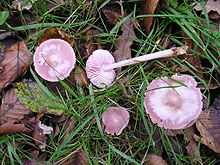Mycena pura
| Mycena pura | |
|---|---|
 | |
| Scientific classification | |
| Kingdom: | Fungi |
| Division: | Basidiomycota |
| Class: | Basidiomycetes |
| Order: | Agaricales |
| Family: | Mycenaceae |
| Genus: | Mycena |
| Species: | M. pura |
| Binomial name | |
| Mycena pura (Pers.) P. Kumm. | |
| Mycena pura | |
|---|---|
|
| |
| gills on hymenium | |
| cap is conical | |
| hymenium is adnate | |
| stipe is bare | |
| spore print is white | |
| ecology is saprotrophic | |
| edibility: poisonous | |
Mycena pura, commonly known as the lilac bonnet,[1] is a species of mushroom in the Mycenaceae family. First called Agaricus prunus in 1794 by Christian Hendrik Persoon, it was assigned its current name in 1871 by German Paul Kummer.[2] Mycena pura is known to bioaccumulate the element boron.[3]
Bioactive compounds
Mycena pura contains the chemical puraquinonic acid, a sesquiterpene. This compound induces mammalian cells (specifically, the cell line HL60) to differentiate into granulocyte- or macrophage-like cells. The fungus also contains the antifungal metabolite strobilurin D, previously found in Cyphellopsis anomala.[4]
See also
References
- ↑ "Recommended English Names for Fungi in the UK" (PDF). British Mycological Society.
- ↑ Kummer P. (1871). Der Führer in die Pilzkunde. Zerbst. p. 107.
- ↑ Vetter Y. (1995). "Boron content of edible mushrooms of Hungary". Zeitschrift fur Lebensmittel-Untersuchung und Forschung 201 (6): 524–27.
- ↑ Becker U, Erkel G, Anke T, Sterner O., U.; Erkel, G.; Anke, T.; Sterner, O. (1997). "Puraquinonic acid, a novel inducer of differentiation of human HL-60 promyelocytic leukemia cells from Mycena pura (Pers. Ex Fr.)". Natural Product Research 9 (3): 229–36. doi:10.1080/10575639708048319.